iPod touch (2010), the fourth generation of Apple's app-enabled, phone-disabled iOS platform brings with it everything we've been waiting for in a mini tablet, but nowhere near enough of it. But that's often the ecstasy and the agony of Apple.
Since we've already posted both our iPhone 4 review, which has similar hardware, and iOS 4.1 walkthrough, which covers much of the same software, we're going to encourage you to check both those articles for more on what's the same and focus here on what's different.
So is it a worthwhile upgrade from last year's iPod touch? A realistic alternative to iPhone 4 for those who prefer other phones? A more pocketable option to iPad?
Check out the iPod touch in 10 minutes video for the quick answer up top and keep on reading for the full review.
iPod touch (2010) hardware
This year's iPod touch is, of course, thinner than last year's. It's ridiculous at this point: 4.4 inches (111.0 mm) tall, 2.3 inches (58.9 mm) wide, 0.28 inch (7.2 mm) thin, and only 3.56 ounces (101 grams).
That's only slightly shorter and narrower than iPhone 4, but an incredible 0.17 inches (2.1mm) thinner and 1.4 ounces (26 grams) lighter.
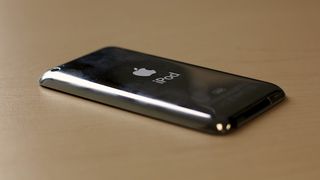
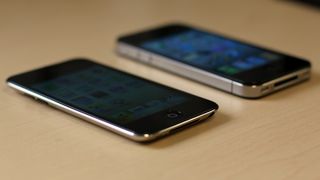
Ridiculous. For a child it's might be perfect but for an adult with adult sized hands it feels almost as though you could fold it in two and crush it if you held it wrong. (You can't, it's glass and stainless steal, but it's just so skinny...)
Unlike iPhone 4, iPod touch 2010 keeps the same old volume rocker as previous years. The sleep/wake button has been moved though and is now in roughly the same position as iPhone. Due to the sharpness of the taper, however it can be hard to press.
The taper also makes it hard to plug in the dock cable, at least harder than last year's iPod touch. The angle is just not friendly. The dock is flanked by external speaker and, still on the bottom, 3.5mm headset jack.
Brand new to iPod touch 2010, there's -- finally! -- a camera along for the ride. Two, actually. A front facing, VGA camera sits above the 960x640 LED Retina Display, and a 720p HD video camera that can also capture 0.7mp stills on the back. There's no LED flash, though, but there is a mic, also at long last.




Retina Display
The new iPod touch gets almost the same 960x640 LED Retina Display as iPhone 4. Almost in that, unlike iPhone 4 and iPad, this panel doesn't use IPS (inter-plane switching). Technically that means it shouldn't have as wide a viewing angle as the iPhone or iPad but in practice I barely noticed. Especially if I cranked the brightness, the display remained clear enough from a wide enough angle that I didn't miss IPS at all.
It's still 326 ppi (pixels per inch) so icons look cleaner, text looks sharper, and graphics of all kind looks all kinds of awesome. You don't really notice it until you go back to a 2009 iPod touch with only 25% the number of pixels, but once you do you really appreciate the difference. Here's a capture of the video above showing iPod touch 2009 (left) and iPod touch 2010 (right).

Cameras
iPod touch 2010 does what iPod touch 2009 couldn't -- get Apple to include a camera. (It probably stole it from the iPod nano, shhhh!). In fact, it's gotten two cameras. The front camera is the same as iPhone 4. It's VGA quality for video and stills and that means it's pretty much constrained to FaceTime video calls and profile picture snap shots.
The rear camera can record 16:9 720p HD video, just like iPhone 4. Where iPhone 4 can also take 5mp stills with auto-focus and LED flash, however, iPod touch 2010 can only take 720p (960x720, they cut off the edges to make it 4:3) still captures (0.7mp). Disappointing. If Apple hadn't insisted it get thinner every year, maybe an iPhone 3GS style 3.2mp, auto-focusing camera could have fit into a thin-enough package.
You can tap to set white balance, though.

Here's a sample photo. Click/tap to see it full size.

Here's a sample HD video recorded with iPod touch (and uploaded to YouTube directly, see below). Set it to 720p to view it full resolution.
If you think about iPhone 4 as a great mobile still camera that also takes HD video, and iPod touch as a good mobile video camera that also captures frames you'll have your expectations set.
It works and works well for casual video and the kind of quick, camera-you-have-with-you shots typically associated with feature phones.
Speaker and mics
Yes, iPod touch 2010 finally has a mic. It's for FaceTime and for FaceTime is works well. It's not a phone mic, and it's position on the back of the device should tell you that, but it works well enough for speaker-phone type situations and apps.
Likewise the speaker won't win any sound prizes from the golden ears but for FaceTime conversations, casual gaming, and listening to podcasts or audio books sans headset it's perfectly fine.
Internals
Apple's A4 chipset -- the custom combo of ARM Cortex A8 CPU and PowerVR SGX GPU -- goes for the threepeat with iPod touch. Unlike iPad where Apple proudly proclaimed the A4 was firing at 1GHz, they're treating iPod touch more like iPhone 4 and not mentioning the specs at all. It could be clocked down, it could be dynamic -- we don't know. I do know it throws Epic Citadel level games and graphics around with reckless abandon and sips power while doing so with the best of them.
256MB, same as last year's model and half what iPhone 4 has, however, is noticeable and annoying. Apple hasn't confirmed this either but independent tests and tear downs suggest it. Where I can keep 6-8 Safari pages cached in memory on iPhone 4, iPod touch 2010 starts to reload at 3. Where iPhone 4 multitasks smoothly from high intensity game to video to anything else, iPod touch feels like it slows for a few seconds as apps save state before it ramps it up again.
Unlike previous years, the NAND Flash storage didn't got up either. We get the same storage options we got before -- 8GB (?!), 32GB, and 64GB. No 128GB. With the new Apple TV being no-storage, stream-only, maybe Apple doesn't think 128GB is necessary? Those who still buy iPod classic, however, would likely beg to differ.
The battery life is also less, 10 hours video for iPad and iPhone 4 but only 7 hours for iPod touch. Again, I blame Apple's obsession with thinness. If they hadn't shaved off that extra millimeter and change, a beefier battery probably could have been fit into the package.
Also inside is a new, 802.11n compatible Wi-Fi radio (2.4GHz only), and a six-axis gyroscope. Both are welcome additions. The first lets you download everything from apps to web pages, and send emails and pictures faster, the other gives you far greater, more visceral-feeling control over games.
There remains no GPS, though Apple has only ever included GPS in 2G/3G capable devices so it could use aGPS for speedier location services.
Accessory compatibility
Once again, new form factor means new cases. Cables, Bluetooth, and anything that plugs in to iPod touch should be fine. Anything that needs to fit its specific shape will have to be bought again.
Worst of the best
No doubt about it, Apple added excellent, long anticipated features to iPod touch 2010 -- Retina Display, A4 chipset, cameras. But at the same time each of those things is worse than iPhone 4's version of the same -- no IPS panel, no 512MB of RAM, no decent still sensor.
But iPod touch is never meant to be comparable to the same year's iPhone. It's meant to be a low barrier of entry to the iOS, an inexpensive, contract free way to get into the App Store. To make it cheap Apple has to keep the costs down. No 3G radio, no 128GB, no spec parity with iPhone. iPod touch has always been as much about the compromises as it is the features.
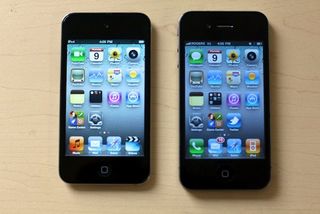
Software
iPod touch 4 comes stock with iOS 4.1, the first point release to Apple's fourth generation mobile software platform. Again, since we've already covered iOS 4.1 extensively, including how it works on iPhone 4 (above), we're going to focus here on how the key new features feel on iPod touch 2010.
But first, lets just take a look at how the 2010 home screen compares the the original one from 2007...


Filled out a bit, hasn't it?
FaceTime
FaceTime on iPhone 4 connects via telephone number. Since that can't work on the telephone-less iPod touch, iOS 4.1 introduces the ability to use Apple ID associated email addresses for FaceTime. (That means, if you want to call someone with an iPhone 4, they have to have updated to iOS 4.1).



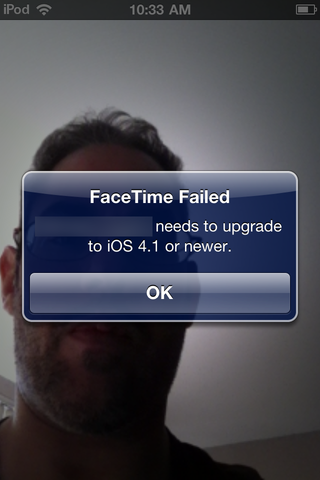
Once it's set up it works the same -- that is, simply and elegantly. It reminds me once again that while Apple certainly didn't invent video calling they've made it incredibly accessible to the mainstream.
If Mac and Windows get FaceTime, if other mobile devices pick up and run with the FaceTime protocol, if it really becomes ubiquitous it will make iPod touch a very interesting VoIP handset.
HD YouTube uploads
To go along with the new 720p video camera on the iPod touch 4, iOS 4.1 lets you upload those HD videos directly to YouTube at full resolution.
To upload you simply pick the video, tap the action button, tap YouTube, login if you need to, then fill out the fields and choose HD. You need to be on Wi-Fi for HD to be enabled, but if you are uploads are fairly snappy and results fairly good. (You can see the sample video in the camera section above.) Once the upload is done you'll be given the option to see or share the video, though often it takes YouTube a while to actually process it and make it available.
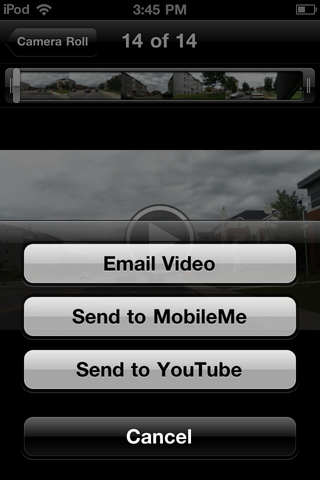
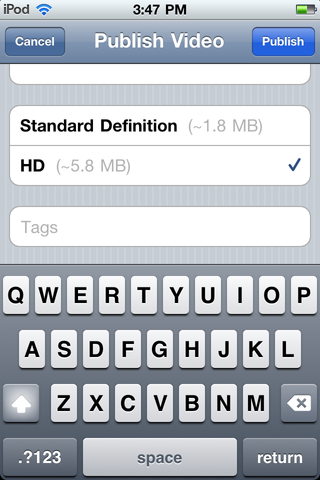


My only gripe is that Apple only allows single word tags while YouTube itself allows multi-word tags. So, I can't enter "ipod touch" as a tag. Sigh.
Game Center
When I've previously looked at Game Center it was either in developer sandbox mode or just coming on line. Well, now it's here and more and more games are updating to support it every day.
Whether Apple initially expected it or not, iPod touch has inarguably become a hit mobile gaming platform. And now as Microsoft gets set to bring Xbox Live-ish to Windows Phone 7 and rumors swirl of a PSP phone built on Android 3.0, Apple becomes first to market with a first-party social gaming platform all their own.
Not that users have been lacking for this type of service before, with options from Open Feint to Plus+ network. How does Apple's compare?
To start off, you can create an account, update your status, and add friends.






You can also see a list of your games that support Game Center. Tapping on one gives you general info and the ability to hit Play and go straight to the game. Tapping on Leaderboards lets you see top scores for Today, This Week, and All Time.

Achievements shows everything you can earn for playing the game.

Games that support Game Center show a brief drop-down when they start.
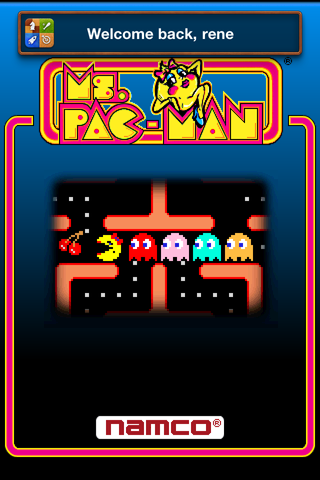
What it doesn't do (at least so far) is what I like most about ngmoco's Plus+ network: keep my gaming sessions in sync across devices. I can go from playing on my iPad to iPhone to iPod touch and back and each time I resume right where I left off the last time. Game Center keeps my account scores and achievements, but as far as I can tell it doesn't let the game save my state to the Game Center cloud.
So, for now, it's powerful and integrated but limited in scope.
Hardcore software
Along with the other new features in iOS 4 and iOS 4.1, everything from multitasking to folders, unified inbox for email to wallpapers, from TV rentals to Ping social music network, iPod touch has become a far more compelling device than it was last year -- when it was very compelling.
Almost all of these features, for the first time, came as free upgrades to last year's iPod touch as well, absent those that depend on new hardware like the cameras, which also makes it strangely less compelling for those who have the 2009 version.
From a pure software perspective, exclusively new to iPod touch 2010 are FaceTime and Camera, but along with them come the ability to shoot and upload your own pictures and videos but more -- to use camera-related App Store apps for the first time -- which includes Augmented Reality. That was a category completely denied to the iPod touch previously and one still denied the iPad.
Pricing and availability
iPod touch is available now and comes in 3 models: 8GB for US$229, 32GB for US$299, and 64GB for $399.
Since $70 is the only difference between 8GB and 32GB, unless you're on a seriously tight budget, that's almost a no-brainer. Another $100 for 64GB is a little tougher to rationalize unless you're a serious high bitrate music lover or app hoarder.
Conclusion
iPod touch 2010 is a serious but not perfect update. It adds so many things it's impossible not to recommend it, but at the same time cuts enough corners that it's just as hard not to quietly curse about it at the same time.
When you figure that an unlocked iPhone 4 will cost you over $600 for 16GB, $300 for a 32GB iPod touch shows why those corners were cut but having a tricked out high end option for those who want a great camera and lots of RAM but no cell contract would have been ideal.
Still, $300 for 32GB and it's your pocket camera, mobile game platform, VoIP handset, mini internet tablet, and -- oh yeah -- media player.
Killer convergence at a killer price.
It's easy to understand why Microsoft's ill-fated Zune HD was the only competition for the last gen iPod touch, and why the only competition for this one are upcoming 7" Android tablet attempts. It's also easy to see why everything from the Flip to the PSP are in trouble. iPod touch brings so much together, at such a relatively cheap price, with such a huge platform base, unless you hate simply dislike Apple products it's the absolute best deal for the best device on the market.
It's kept a notch below iPhone and iPad, but its leaps and bounds ahead of anything else on the market and that doesn't look to be changing any time soon.
Compared to other iOS devices, Apple makes the choice simple. If you want 3G always-on internet and don't mind a data plan, get an iPhone. If you want a much larger screen, get an iPad. If you just want a highly portable way to get onto the internet and into the App Store, that's the iPod touch.
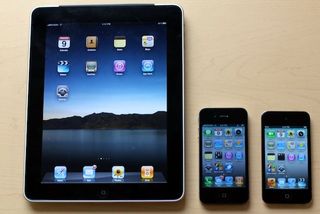


Rene Ritchie is one of the most respected Apple analysts in the business, reaching a combined audience of over 40 million readers a month. His YouTube channel, Vector, has over 90 thousand subscribers and 14 million views and his podcasts, including Debug, have been downloaded over 20 million times. He also regularly co-hosts MacBreak Weekly for the TWiT network and co-hosted CES Live! and Talk Mobile. Based in Montreal, Rene is a former director of product marketing, web developer, and graphic designer. He's authored several books and appeared on numerous television and radio segments to discuss Apple and the technology industry. When not working, he likes to cook, grapple, and spend time with his friends and family.
Most Popular



